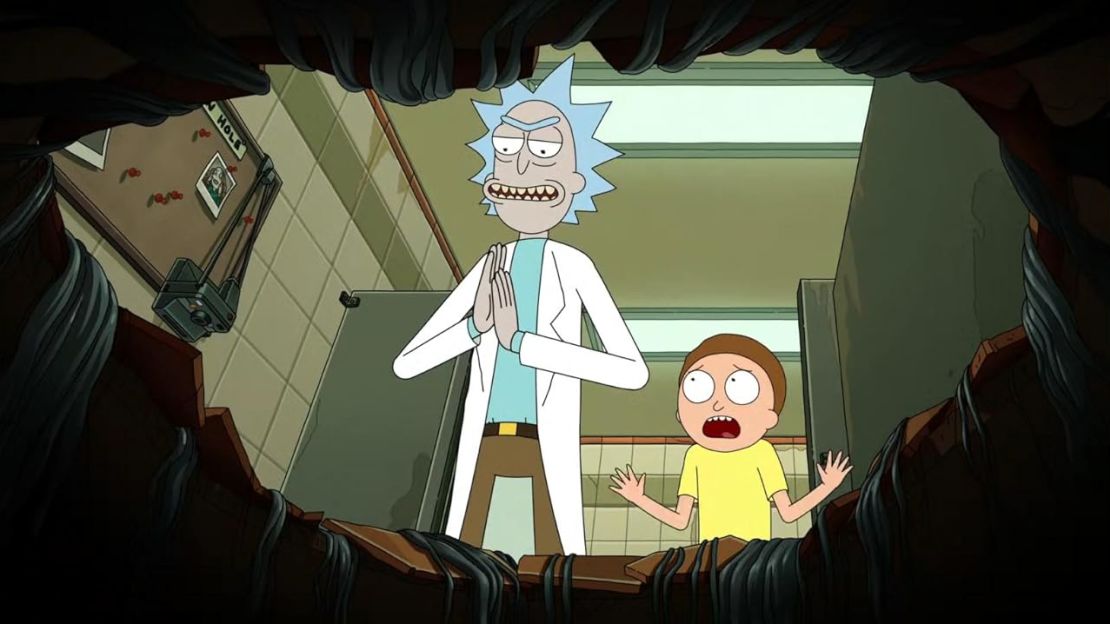Editor’s Note: This is part of a series about how long-running animated comedy shows stay relevant. Read about how “Bob’s Burgers” keeps getting better thanks to its writers taking big leaps and how “The Simpsons” team uses its historic longevity to its benefit.
[This story contains mention of suicide. If you or someone you know is struggling with suicidal thoughts or mental health matters, please call the National Suicide Prevention Lifeline at 988 (or 800-273-8255) to connect with a trained counselor or visit the NSPL site.]
CNN
—
After 10 years on the air, “Rick and Morty,” the animated sci-fi comedy about a misanthropic scientist and his 14-year-old grandson’s interdimensional adventures, is surprising as ever.
In its seven seasons, it has steered its characters through apocalypses, divorces, an alien musical reality TV competition and school dances — events with equal gravity in its off-kilter universe. There are very few rules in “Rick and Morty,” which makes the job all the more fun for its writers, who are working on its eighth and ninth seasons now.
But in the middle of its seventh season, which ended in December, “Rick and Morty” made its most shocking move yet –– it finally gave Rick what he’s spent more than half of his 70-odd years seeking.
Rick finally killed his mortal enemy, Rick Prime, in the fifth episode of the show’s recent 10-episode season. Rick Prime, a cruel version of Rick from another dimension, killed our Rick’s wife, throwing his life off-course. Our protagonist’s curdled, single-minded pursuit of vengeance eventually led him to rejoin his family, recruit his daughter Beth’s teenage children for his interdimensional travels and set the series in motion.
But true to “Rick and Morty’s” deeply cynical tone, Rick feels nothing when he kills Rick Prime in a series of increasingly brutal punches. Afterwards, back at his family home, while Morty rejoices in Rick’s “victory,” Rick is as numb as a zombie. The act of killing his enemy, Rick realizes, was ultimately meaningless and does nothing to ease the loss of his wife. It takes him a few episodes to shake his despair.
“Rick and Morty,” says series writer Heather Anne Campbell, is incredibly silly but utterly serious about the weirdness of being alive.
“It’s trying to get at some deeper, funnier, dumber, more nihilistic truth about what we’re doing here,” Campbell told CNN. “The most effective way to demonstrate that to an audience is like, yeah, have you achieved your goal? And it doesn’t feel like anything? What does that mean? Because that’s something everybody experiences, I think, all the time.”
To love “Rick and Morty” is to know that it can go anywhere at any time, from the planet Alphabetrium, made up of letter-shaped beings including the rapper Ice-T, to Viking Valhalla with Bigfoot. There are endless possibilities in the world(s) it’s built, where substance-addled scientist Rick is the self-proclaimed smartest man in the universe and can do pretty much anything except readily admit his love for Morty, granddaughter Summer or Beth, or anyone beyond his best friend, the recently resurrected Bird Person.
The season wasn’t all major revelations and deeply sad dramatic beats, though. Just a week before that pivotal installment, “Rick and Morty” aired an episode in which Rick feeds his family delicious spaghetti that they discover was made from a dead body. (Campbell wrote that one, plus the season seven finale.)
That’s the fulfilling joy of writing for “Rick and Morty,” Campbell says –– its “infinite sandbox.” No idea is off limits as long as it rings true in the universe of “Rick and Morty” and to its viewers, be it the moral cost of a spaghetti dinner or the emptiness felt after vanquishing a foe.
“The six seasons previous have shown us that literally anything can be an episode,” she said. “And the strength of the show is taking any of these completely absurd sci-fi concepts and really interrogating them and trying to illuminate some stupid truth about what life is and what we’re experiencing.”
As in previous seasons, “Rick and Morty’s” seventh season was profane, uproariously funny and often deeply upsetting. (“Rick and Morty” is a property of Warner Bros. Discovery, the parent company of CNN.)
It was the first to air after Justin Roiland, who co-created the series with Dan Harmon and voiced both title characters, was fired due to allegations of sexual assault. But his departure didn’t kneecap the series –– new actors Ian Cardoni and Harry Belden were brought in to voice Rick and Morty, respectively, and the show continues to probe the mysteries of life in outlandish scenarios, asking questions like, Would you stage an intervention for your alcoholic friend whose wife left him for the Predator? And also, what if Hugh Jackman was there?
Nihilism is where “Rick and Morty” thrives –– in the very first season, our title characters abandoned Morty’s home planet with his parents and sister still on it after they unleashed a Cronenberg-ian mutation that turned everyone into oozing, murderous monsters, and all because Morty asked Rick for a love potion.
But by the end of this seventh season, our title characters have emotionally matured somewhat. The pair get a subtly sweet moment in the season finale: Rick and Morty have grown jaded by the horrors they’ve seen across dimensions and find they can no longer be scared. Eager to feel the jitters again, they leap into something called the Fear Hole, which brings to life their deepest anxieties. For Morty, that’s a life where Rick leaves.
Inside the hole, Morty meets a version of Diane, Rick’s dead wife. Morty’s fear manifests a version of Rick, who Diane tries to convince to stay in the hole — even though it’ll kill him.
Morty finally climbs out of the hole, but only after confronting his fear that Rick could leave the family as suddenly as he reentered their lives, stranding Morty in an unremarkable life once again.
“Am I … irreplaceable?” Morty asks Rick once he’s left the hole.
Rick, ever withholding, counters: “Define irreplaceable.”
“That’s good … good,” Morty says, hugging Rick tightly, a rarity in the series. “I’m back.”

Teetering on the edge of the hole, which is inexplicably located in a bathroom stall inside a Denny’s, Rick is briefly tempted to find Diane, a choice made weightier by Rick’s recent killing of the man who killed her. Instead, he pulls a photo of Morty out of his wallet and pins it to a corkboard inside the stall to signify, with pride, that his grandson is one of the few to make it out of the Fear Hole alive.
It’s as close as Rick can come to admitting he loves his grandson. The quiet moment lands because it’s taken Rick so long to go that far –– and leaves the rest of the series wide open.
It’s an exciting prospect for viewers and even for Cardoni, the new voice of Rick, who doesn’t know where the series is headed either.
“The character is growing,” Cardoni told CNN ahead of the finale. “We’ve seen some great turns with (Rick) just in the season, in terms of his emotional health and mental health. We’ve seen it working, and we’re seeing him open up in different ways. I’ll bring to that whatever I can, but I think the character is what’s alive now.”
Because an episode of “Rick and Morty” can start from anything, Campbell pitched the idea for suicide spaghetti. It starts out like a “classic ‘Rick and Morty’ adventure” in which Morty morally objects to something Rick does –– in this case, serving delicious spaghetti to his family that’s actually made from the remains of people whose insides turn to pasta only when they die by suicide.
Harmon wasn’t sold on the concept as an entire episode at first, Campbell said, but encouraged her to riff on it. It turned into “That’s Amorte.”
At first, the episode feels like it’s taking a blackly comic take on taboo subjects to disturbing extremes –– fairly typical terrain for a series that once featured a “soul orgy” between Rick, Morty and Summer, plus a gaggle of dragons. But it turns oddly moving once the suicide spaghetti industry balloons and Morty finds himself complicit in its success. Rick ends the demand for pasta for good by hooking a dying man up to a machine that broadcasts scenes from his life to those watching across the planet. Eating the remains of a man who lived, lost and loved is suddenly no longer appetizing.
“I wanted to get across that life is not a direct path from one point to another –– it is a constantly meandering river,” Campbell said of the montage of the man’s life. “But that doesn’t rob it of meaning, especially if you look at the entire thing all at once.”
The spaghetti episode only worked because co-creator Dan Harmon and showrunner Scott Marder were “fully indulgent and patient” in letting Campbell explore pasta as a plot device and developed it with her from the very beginning of the pitch process, she said.
“Tapping that excitement for an area usually leads to stronger drafts for each episode on the whole,” Marder told CNN.
As for the ideas that make it that far, the “energy in the writer’s room” is the most important barometer of potential, Harmon told CNN.
“It’s not necessarily about everyone laughing, but it is about them being excited –– when two or more writers start talking over each other, and everyone is pitching very different possibilities,” he said. “If two people can disagree fundamentally about how they’d use X-ray glasses, that’s a sign there may be a story’s worth of energy in X-ray glasses.”
Or, spaghetti. Campbell’s pasta-centric episode tonally fits right in alongside the bleak episode in which Rick Prime dies.
“We always say every episode needs to run a marathon, in terms of its lifespan, from a kernel of an idea to making it to air,” Marder said, “so an idea really works when it’s got a strong enough engine in it to help power it, and our enthusiasm for it, through that 26-mile race.”
“Rick and Morty” writers are working on the next three seasons at once, in varying stages of development. It’s helpful that way, Campbell said, because they can easily chart how a major canonical move will reverberate in a future season.
For example: With his death, Rick Prime ceded his position as the show’s major villain to Evil Morty, who helped our Rick find his nemesis — but, by the episode’s end, has the power to destroy all Ricks in every dimension, upsetting the show’s balance at any time.
Where “Rick and Morty” goes next is anyone’s guess, especially with a dead Rick Prime and rogue Evil Morty. But the unknown is the point of the series, Campbell said.
“The future is so terrifying,” she said. “Being alive is a puzzle. And those things colliding against each other is where the show is going.”











